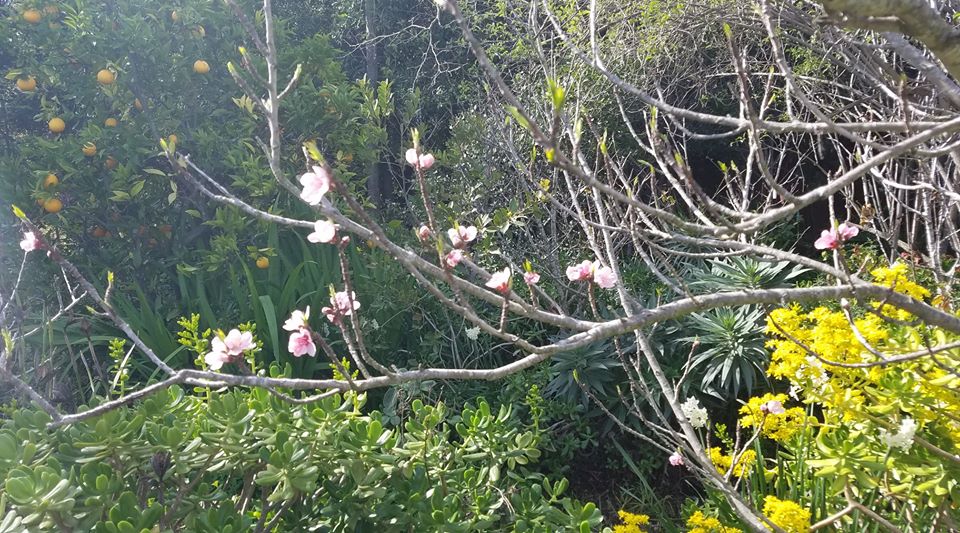Food Forest Landscaping
Healthy Lives Through Food Security, Social Justice, Climate Adaptation

We have learned a tremendous amount recently from the COVID crisis, Black Lives Matter protests, and Climate Justice movement. First, not only are our food supply chains long, vulnerable, and wasteful, but the impacts of our health and economic crises fall primarily on already marginalized minorities. Second, not only does our criminal justice system brutalize and kill our brothers and sisters of color, but structural racism oppresses them economically, socially, and health wise. And third, not only is the climate crisis an accelerating emergency, but its destructive and deadly effects fall first and foremost on oppressed people of color in our country and around the world.
One very practical thing we can do now that integrates what we are learning is to come together in our yards and public spaces to grow healthy food for our whole community. This wouldimprove our health,strengthen our immune systems, increase food security, cultivate community solidarity, mitigate the climate crisis, and even help begin to redress racial and economic injustice. Thisis of course only a partial solution to any of these crises, but it is something we can do right now that helps resolve all of them at the same time. We can even do this during the pandemic because the coronavirus is not easily spread outdoors and we can keep a safe social distance while working outdoors.
The best way to grow food in a city like ours is through food forest landscaping. Food forest landscaping is a blend of aesthetic landscape design, organic food production, and ecological science. This combination results in beautiful human-designed forest-like ecosystems that produce abundant food and other useful yields. These landscapes provide space for outdoor enjoyment, require minimal supplemental water, and are very low maintenance once established.

Blending multiple layers from the root level up to the highest tree canopy into an integrated ecosystem, food forests include fruit and nut trees and shrubs, perennial and annual vegetables, herbs, flowers, vines, and beneficial companion plants. Optional small domesticated and wild animals like chickens, bees, and owls (to control pests) can help create a largely self-sustaining ecosystem.
Strategically designed to fit climate, soil, and site conditions, food forest landscaping is the most efficient way to grow food. Some its benefits are:
It makes us healthier and happier: Through exercise, fresh air, healthy food, and sun (for Vitamin D) chronic disease is reduced and our immune systems are boosted to protect us against infectious diseases like COVID. Furthermore, most people find gardening and growing food therapeutic.
It helps build a secure and sustainable food system: Food grown locally and organically is fresher, healthier, and less wasteful. It is more affordable because it eliminates most transport, intermediary, and environmental costs. It is more secure because the supply chain is short. And it can be sustained for generations.
It helps unify our community and redress inequities: When we work outdoors growing food together across ethnic, socioeconomic, and ideological differences we come to understand and care for one another. This can heal our divisions while we channel abundant healthy food to those who are oppressed and marginalized.
It greatly reduces energy consumption and mitigates the climate crisis: Our current food system generates a major portion of our total carbon emissions. When we cooperate with nature and grow food locally, we eliminate most fuel, energy, and labor inputs for production and transport. Food forest landscaping even pulls carbon from the air to store in trees, plants, and soil.
It increases biodiversity and improves local micro-climates: Food forest landscaping harbors more diverse plant, animal, and pollinator species than most ornamental landscapes or modern farms. At the same time it moderates air temperatures, retains moisture, and improves local water cycles.
It helps revitalize our way of life while teaching ecosystem awareness and regenerative food production: Meeting much of our food needs together as a community helps create a fulfilling culture of local self-sufficiency and global solidarity. In a practical hands-on way, an organic food forest ecosystem demonstrates the principles of a sustainable way of life.
Food forest landscaping is a solution we can all contribute to now that builds local food security, advances social justice, and mitigates the climate crisis. It helps create a healthier, less wasteful way of life that cultivates more satisfying relationships with one another and our Mother Earth. And summer is the perfect time to plan a food forest landscape, sheet mulch the land to eliminate grass and weeds and build soil, and plant some trees to start with.
To learn more about how to establish a food forest landscape or participate in any way contact Brad Smith a bsmith.interplay@gmail.com or (805) 705-5844.




You must be logged in to post a comment.